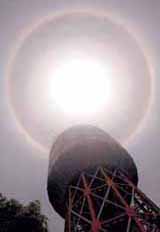


Ribuan warga Medan, Sumatera Utara berbondong-bondong ke luar ruangan untuk menyaksikan fenomena unik. Secara tiba-tiba sekitar pukul 11.00 WIB matahari di atas langit Medan tidak seperti biasanya. Terdapat sebuah lingkaran hitam yang mengelilingi bulatan matahari. Selain itu, tiga warna lain juga turut mengitari matahari secara berlapis. Sehingga matahari tampak seperti dilingkari warna pelangi. Hal ini biasanya disebut "Halo". Uniknya, meski cuaca cerah dan mentari bersinar terang namun sengatan sinat matahari tidak begitu terasa. Kondisi ini berbeda dengan sebelum adanya lingkaran warna di matahari.
Berdasarkan pantauan di lapangan, Senin (22/9/2008) fenomena aneh ini diketahui warga setempat dari pantulan sinar matahari di kaca mobil yang lewat. Pancaran sinar aneka warna memancar dari pantulan kaca mobil yang lalu lalang di jalan. Merasa penasaran, beberapa orang warga melihat ke atas dan menemukan matahari telah dilingkari warna hitam dan beberapa warna lain. Akibat peristiwa alam ini, Jalan Pengadilan di Medan sempat mengalami kemacetan karena ratusan pengunjung sidang berbondong-bondong keluar ruangan untuk menyaksikan hal ini. Bahkan, seorang hakim dengan pakaian toga dan memegang palu sidang turut ke luar ruangan untuk memeriksa kebenaran informasi yang didengar.















